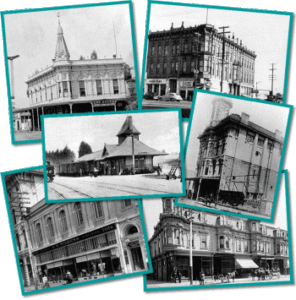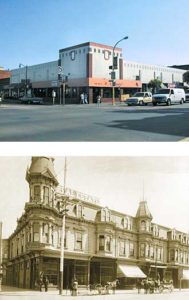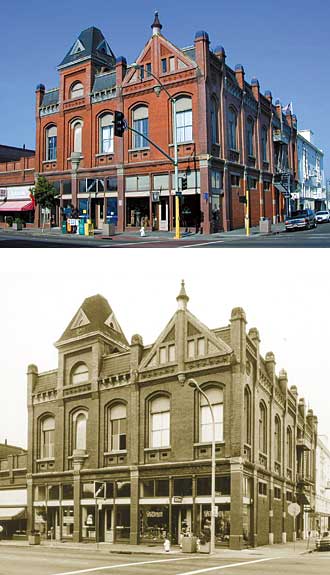Historic Downtown Alameda – Respect Your Elders
 Sometimes, “what’s new” is not as interesting as “what’s old.” That’s the case with our great old buildings in Downtown Alameda.
Sometimes, “what’s new” is not as interesting as “what’s old.” That’s the case with our great old buildings in Downtown Alameda.
Prior to 1864, Alameda was home to a few small farmhouses scattered around the peninsula. However, things changed that year when a rail and ferry system was introduced to the city.
With improved transportation, hubs of commerce sprang up along the train routes. The primary local stop for the San Francisco & Alameda Railroad was Alameda Station, located near what is now the intersection of Lincoln Avenue and Park Street. From that point, businesses spread out mostly in a linear fashion along a road that divided two large tracts of land. That road ultimately became “Park Street.”
Between 1877 and 1880, more than thirty large ornate commercial buildings were erected — ones that were grander than their wooden predecessors. In 1896, Alameda’s City Hall building was completed and by 1905 over 150 structures lined Park Street and the surrounding roads.
There were a few building booms following The Great Earthquake (1906) and between the two World Wars. But the old Victorian landmark buildings didn’t seem that cool any more, so they were either torn down or converted into something else. Thankfully, thirty of the historic structures were left standing, including one that still retains its original architecture.
It was in 1981 that a group of merchants in their wisdom applied to have Alameda’s downtown area designated a national historic business district. Since then, from an architectural standpoint, Park Street has pretty much remained as we see it today.
We invite you to stroll through Downtown Alameda and look for the buildings that are contributors to the Park Street Historic Commercial District (National Register, 1982):
Schroeder Building
1435-1437 Park Street
 Believe it or not, this is the oldest building in what is officially designated as the “Park Street Historic District.” While significantly altered over the years, it retains some of its original design.
Believe it or not, this is the oldest building in what is officially designated as the “Park Street Historic District.” While significantly altered over the years, it retains some of its original design.
The corner structure was built in 1873 for Fritz Boehmer, a local merchant and real estate developer. Fritz had a grocery and hardware business in the ground floor and the upper floor contained a public meeting hall. In 1876, Fritz sold the building to Adolph Schroeder, who expanded the building in 1889.
Between 1882 and 1894, a portion of the ground floor housed Alameda’s first telephone exchange.
What’s there now? China House occupies the upper floor. Work is currently in progress for a lounge on the lower level to be called Town Tavern.
 Tucker Building
Tucker Building
1430-1440 Park Street and 2402-2406 Santa Clara Avenue
Beneath the stucco and wood facade of this building is the remnant of an ornate, three-story Italianate landmark. The original structure was built for Dr. Joseph C. Tucker on a portion of the grounds previously occupied by his Alameda Park Asylum, a privately-run insane asylum.
The Tucker Building was built in two phases. The ground floor housed a variety of commercial tenants, including Alameda’s main post office between 1879-1890. The second floor held professional offices, while the third floor – left unfinished until 1882 – contained furnished rooms for rent.
Purchased shortly after World War I by local real estate agent, the building was completely remodeled in 1933. The design is now a fine example of the Moderne style.
What’s there now? La Penca Azul first started operating from the corner space over 25 years ago and has slowly expanded into the nearby spaces on both streets.
 Old Masonic Temple
Old Masonic Temple
1327-1331 Park Street
This is the only monumental Victorian building remaining in its original form within the Park Street Commercial District — a structure that was completed in 1891. The style is essentially Italianate with Queen Anne and Romanesque Revival elements. The dark red pressed brick facade is embellished with carved sandstone, granite, molded terra cotta, pressed galvanized iron, and slate. The Masons final meeting in the Temple was in 1927, when a new temple was dedicated next door. They ultimately sold the building in 1979.
What’s there now? Its ground-floor spaces are currently leased to various retail businesses: The Local Coffee House, Supercuts, and Salon One.
There are many more historic structures to see! Keep an eye on this site for future posts or view the history of Downtown Alameda on our website: www.DowntownAlameda.com/History.
